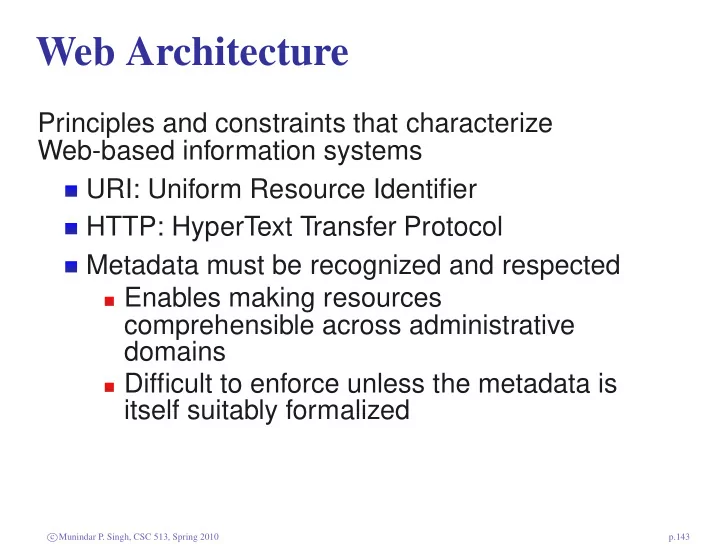

Web Architecture Principles and constraints that characterize Web-based information systems URI: Uniform Resource Identifier HTTP: HyperText Transfer Protocol Metadata must be recognized and respected Enables making resources comprehensible across administrative domains Difficult to enforce unless the metadata is itself suitably formalized � Munindar P. Singh, CSC 513, Spring 2010 c p.143
Uniform Resource Identifier: 1 URIs are abstract What matters is their (purported) uniqueness URIs have no proper syntax per se Kinds of URIs include URLs, as in browsing: not used in standards any more URNs, which leave the mapping of names to locations up in the air � Munindar P. Singh, CSC 513, Spring 2010 c p.144
Uniform Resource Identifier: 2 Good design requirements Ensure that the identified resource can be located Ensure uniqueness: eliminate the possibility of conflicts through appropriate organizational and technical means Prevent ambiguity Use an established URI scheme where possible � Munindar P. Singh, CSC 513, Spring 2010 c p.145
HTTP: HyperText Transfer Protocol Intended meanings are quite strict, though not constrained by implementations Text-based, stateless Key verbs Get Post Put Error messages for specific situations, such as resources not available, redirected, permanently moved, and so on ReST: Representational State Transfer � Munindar P. Singh, CSC 513, Spring 2010 c p.146
Representational State Transfer ReST is an architectural style for networked systems that constrains the connectors Models the Web as a network of hyperlinked resources, each identified by a URI Models a Web application as a (virtual) state machine A client selecting a link effects a state transition, resulting in receiving the next page (next state) of the application � Munindar P. Singh, CSC 513, Spring 2010 c p.147
Characteristics of ReST Client-Server Statelessness: in terms of sessions What is an advantage of statelessness? Where is the session state kept then? Focus on resources being manipulated and their representations being transferred Uniform Interface: URIs, hypermedia Caching: responses can be labeled as cacheable � Munindar P. Singh, CSC 513, Spring 2010 c p.148
Basic Interaction Models Interactions among autonomous and heterogeneous parties Adapters: what are exposed by each party to enable interoperation Sensors ⇐ information Effectors ⇒ actions Invocation-based adapters Message-oriented middleware Peer-to-peer computing � Munindar P. Singh, CSC 513, Spring 2010 c p.149
Invocation-Based Adapters: 1 Distributed objects (EJB, DCOM, CORBA) Synchronous: blocking method invocation Asynchronous: nonblocking (one-way) method invocation with callbacks Deferred synchronous: (in CORBA) sender proceeds independently of the receiver, but only up to a point � Munindar P. Singh, CSC 513, Spring 2010 c p.150
Invocation-Based Adapters: 2 Execution is best effort: application must detect any problems At most once More than once is OK for idempotent operations Not OK otherwise: application must check � Munindar P. Singh, CSC 513, Spring 2010 c p.151
DoDAF Department of Defense Architecture Framework A standardized way to organize an enterprise architecture Lists 26 views organized into four categories Roughly, a software methodology How to capture requirements: user activities How to develop solutions: meet performance criteria How to consider technical standards Best for large systems with lifetimes of decades � Munindar P. Singh, CSC 513, Spring 2010 c p.152
Recommend
More recommend